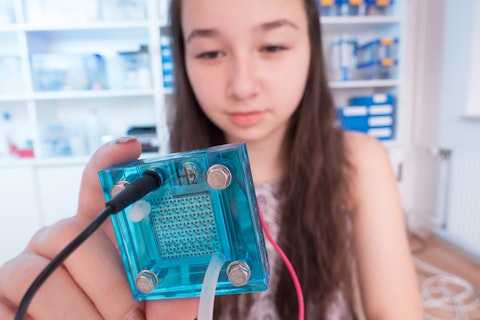Keysight Technologies, Inc. (NYSE:KEYS) Q3 2023 Earnings Call Transcript August 17, 2023
Keysight Technologies, Inc. beats earnings expectations. Reported EPS is $2.19, expectations were $2.04.
Operator: Good day, ladies and gentlemen, and welcome to the Keysight Technologies Fiscal Third Quarter 2023 Earnings Conference Call. My name is Cole, and I’ll be your lead operator today. [Operator Instructions] This call is being recorded today, Thursday, August 17, 2023 at 1:30 P.M. Pacific Time. I would now like to hand the call over to Jason Kary, Vice President, Treasurer and Investor Relations. Please go ahead, Mr. Kary.
Jason Kary: Thank you, and welcome everyone to Keysight’s Third Quarter Earnings Conference Call for Fiscal Year 2023. Joining me are Keysight’s President and CEO, Satish Dhanasekaran; and our CFO, Neil Dougherty. In the Q&A session, we’ll be joined by Chief Customer Officer, Mark Wallace. The press release and information that supplement today’s discussion are on our website at investor.keysight.com under the financial information tab and quarterly reports. Today’s comments will refer to non-GAAP financial measures. We will also make reference to core growth, which excludes the impact of currency movements and acquisitions or divestitures completed within the last 12 months. The most directly-comparable GAAP financial metrics and reconciliations are on our website and all comparisons are on a year-over-year basis, unless otherwise noted.

science photo/Shutterstock.com
We will make forward-looking statements about the financial performance of the company on today’s call. These statements are subject to risks and uncertainties and are only valid as of today. We assume no obligation to update them. Please review our recent SEC filings for a more complete picture of these risks and other factors. Lastly, management is scheduled to participate in upcoming investor conferences hosted by Deutsche Bank, Goldman Sachs, and Citi. And now, I will turn the call over to Satish.
Satish Dhanasekaran: Good afternoon, everyone, and thank you for joining us today. Keysight reported solid results in the third quarter, demonstrating the strength of our portfolio and the resilience of our financial model. We are executing on our strategy and delivering on our commitments to customers and shareholders in a challenging macro-environment. My comments today will focus on three key headlines. First, we delivered another quarter of strong financial performance demonstrating Keysight’s diversified portfolio, strong execution, and operating discipline. Third quarter revenue was in-line with our expectations, while record earnings per share exceeded our guidance range. Second, while orders came in at the low end of our expectations, we saw positive and steady customer R&D spending and continued stability in commercial communications.
Growth in aerospace, defense and government and growth in our automotive EV and AV solutions, partially offsetting incremental softness in EISG and Asia, primarily related to semiconductor and other manufacturing. This backdrop has tempered our near-term expectations for orders and revenue. We’ve factored this dynamic into our outlook for Q4, while now expecting full-year EPS growth of 7%. Third, despite the near-term challenges, Keysight’s diversified business, differentiated solutions, and durable operating model give us confidence in our ability to capitalize on the long-term secular growth trends of our markets, as well as outperform in a variety of market conditions. Now let’s take a deeper look at our third quarter results. While orders declined 15%, revenue of $1.38 billion was up 1% on a core basis and a record for the third quarter.
Our differentiation and strong execution resulted in gross margin of 66% and record operating margin of 31%. We delivered $2.19 in earnings per share, which was an all-time high. Turning to the demand environment, we continue to see steady investment in strategic R&D programs in commercial communications, aerospace, defense and government and automotive EV solutions. In fact, over the past year, we’ve seen a meaningful growth in large long-term customer commitments related to strategic programs, particularly in automotive and ADG. We view this as an important validation of our strategy, it puts us in a strong position in key emerging technologies and positions us well for future growth. Demand was incrementally weaker in Asia this quarter as customers deferred manufacturing-related spending in semiconductor, general electronics, and automotive markets in many cases well into next year.
Taken together, the increase in our customer strategic program investment combined with soft near-term demand environment is moderating revenue in the fourth quarter, which Neil will discuss in more detail. Turning to our business segments. Electronic Industrial Solutions Group revenue grew 14% to another quarterly record and the 12 consecutive quarter of double-digit revenue growth. The strong financial performance was driven by double-digit growth across all markets and regions. EISG orders in the third quarter trended lower, particularly in semiconductor and manufacturing. Our customer engagements remain high as they’re planned for, and continue to invest in key long-term strategic initiatives. In semiconductor, despite a near-term pullback in capital spending for wafer capacity, the industry is marching forward and planning for a strong future demand environment.
In the near term, customers are prioritizing new applications such as silicon photonics to address the AI demand. As a result, this quarter we did see significant slowdown in our new wafer test solutions, while demand for Keysight’s silicon photonics test and proprietary interferometer systems remained high. We expect these dynamics to continue over the next few quarters. In automotive, investments in EV and AV technologies continued to be strong. This quarter we secured a third strategic win with another large European OEM to supply an EV battery test system that includes our PathWave Lab automation software. This program will be implemented in 2025, and we’re quite excited to be working with industry leaders and supporting their goals. To address customer needs for wireless tracking, diagnostics and connected vehicle communications, Keysight also announced support for automated RF testing for Autotalks’ C-V2X chipsets on our PathWave Test Executive software platform.
In general electronics, the growing collaboration between universities and companies is driving further investment in our solutions for advanced research. We’re also expanding on our customer engagement in digital health solutions to support the growing digitalization and connectivity requirements of this industry. Turning to Communications Solutions Group, revenue declined 5%, while the overall stable demand environment continued quarter-to-quarter. Aerospace, defense, and government revenue grew 11% with strong demand from U.S. government and primes. Keysight’s differentiated signal generation and threat scenario emulation capabilities led to a large U.S. Air Force contract in Q3. We also won a key contract from leading Canadian prime contractors for electromagnetic spectrum operation applications.
In addition, the demand for our radar and defense modernization solutions grew robustly as prime contractors placed orders for systems that support their delivery goals in 2024 and beyond. Government research demand and investment in 5G and 6G continued as well. Commercial Communications revenue declined 12% due to cautious spending by customers and weaker manufacturing activity in smartphone, PC, and component supply chain. Customer engagements remained strong with R&D investments in key technology to support 5G and 6G AI/ML-driven high-speed datacenter networking and satellite communications. Demand for our wireline applications improved sequentially driven by cloud provider and hyperscaler investments as they designed their networks for AI and ML workloads.
Enterprise customer and key service provider investment was steady, driven by increased digitization, heavier network loads, and rising cyber security concerns. In wireless, 5G standards are progressing and we saw steady R&D investment in Open RAN, satellite, non-terrestrial networks and 5G RedCap Release 17 capability targeted at industrial and IoT applications. Early 6G engagements continued this quarter. We enabled the University of Stuttgart to advance 6G integrated circuit research with our sub-Terahertz solutions. Keysight also led the agreement between the 6G-SANDBOX consortium and the European Space Agency to further research to integrate terrestrial 5G/6G technologies and satellite networks of the future. This quarter, we continued to strengthen our technology leadership in the industry and enable our customers’ innovation.
For example, we extended our flagship network analyzer portfolio by introducing industry’s first integrated platform with vector component and analysis capabilities for power amplifier and component design applications. We also announced industry’s most comprehensive multi-speed ethernet performance platform supporting data center interconnects up to 800 gigabit ethernet that are critical for data-intensive applications such as AI. And lastly, Keysight enabled 3GPP protocol conformance validation for Release 17 non-terrestrial networks and is continuing to partner with new satellite operators like Skylo to accelerate the deployment of satellite networks. Software and services remain an integral part of our solution strategy and again accounted for one third of total company revenue.
Overall, software and services revenue grew year-over-year reflecting the continued expansion of our software-centric solutions. We remain confident in the long-term secular growth of software intensive R&D applications, particularly earlier in our customers’ development process. In line with this trend and the software system simulation opportunity that I laid out at our March Investor Day, this quarter we announced our intent to acquire ESI Group, a leader in virtual prototyping solutions for the automotive and aerospace markets. The addition of ESI broadens our software capabilities into physical simulation and furthers our strategy of moving upstream into earlier stages of our customers’ design cycles Keysight’s technology leadership and deep collaboration with industry players remains a significant competitive advantage.
Despite current macro uncertainty, we see continued investments in R&D driven by multiple waves of technology innovation and broad-based industrial digitalization and connectivity needs. While continuing to invest in these long-term secular growth trends, we remain disciplined and have driven incremental cost efficiencies throughout the organization this year. Our current guidance expectations are to finish the fiscal year 2023 with 7% EPS growth and 1% revenue growth. We believe this financial performance exemplifies the strength of Keysight’s differentiated first-to-market solutions portfolio, our durable and resilient business model, and our winning culture which altogether positions us well for continued market outperformance. With that, I’ll turn the call to Neil to discuss our financial performance and outlook.
Neil Dougherty: Thank you, Satish, and hello, everyone. We delivered solid financial performance in Q3. Revenue of $1.382 billion was just above the midpoint of our guidance range, flat year-over-year and up 1% on a core basis. Orders of $1.244 billion declined 15% on a reported and core basis. We ended the quarter with $2.3 billion in backlog. Turning to our operational results for Q3. We reported gross margin of 66% and operating expenses of $478 million, resulting in record operating margin of 31%. We achieved net income of $393 million and delivered record earnings at $2.19 per share. Our weighted-average share count for the quarter was 179 million shares. Moving to the performance of our segments. Our Communications Solutions Group generated revenue of $918 million, down 5% on a reported and core basis.
Commercial Communications revenue of $611 million declined 12%, while aerospace, defense and government revenue of $307 million was up 11%, driven by increasing defense budgets worldwide and investments in technology modernization. Altogether, CSG delivered gross margin of 68% and record operating margin of 30%. The Electronic Industrial Solutions Group generated record revenue of $464 million, up 14% or 15% on a core basis with double-digit revenue growth in automotive, general electronics, and semiconductor. EISG reported gross margin of 62% and operating margin of 34%. Moving to the balance sheet and cash flow. We ended our third quarter with $2.6 billion in cash and cash equivalents, generated cash-flow from operations of $241 million and free cash flow of $196 million or 14% of revenue.
Share repurchases this quarter totaled approximately 930,000 shares at an average share price of $162 for a total consideration of $151 million. Now with regard to our outlook. Exiting the quarter and as Satish mentioned, the demand environment was mixed with areas of stability and growth partially offsetting pockets of incremental softening. In addition, the composition of our order mix has changed over the past year. Our ability to deliver differentiated solutions and innovate at the pace of our customers has resulted in meaningful growth and strategic long-term customer commitments, which will deliver high-quality revenue over multi year periods. These commitments were approximately 2% of orders in Q3 year-to-date last year and are approximately 8% of orders year-to-date this year.
Turning to our fourth quarter guidance, which incorporates these factors, we expect revenue to be in the range of $1.290 billion to $1.310 billion. Full-year revenue at the midpoint of our guidance is $5.5 billion, representing 1% growth. We expect Q4 earnings per share to be in the range of $1.83 to $1.89 based on a weighted diluted share count of approximately 179 million shares. Full year earnings per share at the midpoint of our guidance is $8.19, representing 7% growth. As we look to next year with the capitalization of R&D, the pending increase in the guilty tax-rate on offshore earnings, and efforts by the OECD to establish a global corporate minimum tax rate of 15%, we now estimate that our non-GAAP tax rate beginning in fiscal year 2024 will be in the range of 15% to 17%.
With that, I will now turn it back to Jason for the Q&A.
Jason Kary: Thank you, Neil. Cole, please give the directions for the Q&A.
See also Top 20 Spotify Users by Country and 15 Smallest Stocks In Warren Buffett’s Portfolio.
Q&A Session
Follow Keysight Technologies Inc. (NYSE:KEYS)
Follow Keysight Technologies Inc. (NYSE:KEYS)
Operator: Of course [Operator Instructions] Our first question comes from the line of Samik Chatterjee with J.P. Morgan. Your line is now open.
Samik Chatterjee: Yeah. Hi, so many thanks for taking my question. Hi, Satish. Can you hear me?
Satish Dhanasekaran: Yes. We can hear you.
Samik Chatterjee: Hi. Can you hear me? Yes. Hi.
Satish Dhanasekaran: Yes. We can hear you,
Samik Chatterjee: So, if we can start with EISG where you said demand trends or order trends are stable. Maybe if you can sort of dig into that a bit more because there have been concerns given that the smartphone ecosystem still remains really sort of below average in terms of demand that there could be further weakness there. What are you seeing in terms of wireless versus wireline, particularly interested in understanding if you’re seeing any demand uplift from all the uptakes in the AI applications on the wireline side? Just maybe dive into that a bit more. And I have a follow-up. Thank you.
Satish Dhanasekaran: Sure, Samik. Let me just start by saying, the Keysight team executed very well under these conditions, and you see that reflected in the strong quarter and year-to-date performance. Based on our guide we expect to deliver 7% EPS growth for the year, on 1% revenue and we’re maintaining solid profitability. So that’s sort of the baseline. And then when we looked at the orders, obviously the orders were down 10% year-over-year in Q2, and when you look at our orders right now for the quarter that we reported, were down 15%. A big part of that decline year-over-year came from our Greater China operations which were associated with the slowdown in production, which impacted the EISG business which was actually holding up pretty well till the first half.
And we expect that this dynamic to last a few more quarters, again, we think it’s transient. And I want to stress that based on all of the customer engagements, including the fabs that we engage with, they continue to believe that this is a temporary situation that is playing out. Now I also want to sort of elevate this to a regional perspective, because it will get at the core of your question. Our Americas business grew this quarter on top of a record Q3 a year ago, and Europe was stable driven by strength in EV and AV. And again, I’ll go back next to the segment perspective, commercial communications continued to be stable, and I’ll get a little bit into the different segments. Aerospace and Defense grew, and EISG, as I mentioned before, incrementally declined.
From a commercial communications perspective, 5G investments in R&D continued to be stable. And what was driving some of that is, yes, we still are yet to see any uptick in the manufacturing business associated with the components and that’s correlated with your smartphone — declines in the smartphone — in general smartphone volumes. But I think the driver here is the premiumization of the smartphone market, right? And that is really resulting in those customers that have better than expected performance or earnings improvements have actually come back and pulled the trigger on investments with regard to their innovation needs in R&D. And this is again reconfirmation of some of our base-case thinking that the R&D investments are much more robust and our customers don’t want to get behind.
On the wireline side, the dynamics were influenced by AI as a number of hyperscalers are starting to look at the AI through the lens of AI their investments in data center. We started to see some uptick in investments in 800 gig, again, very preliminary, I don’t want to draw too far conclusions, one quarter doesn’t make a trend, but the stability two quarters in a row, we’re quite encouraged by that given the economics. And I also think the breadth of Keysight’s portfolio and the contributions we’re making end-to-end to the communications ecosystem is enabling us to outperform. I would say our Network and Security business or Network and Application Security business, which was formerly Ixia business has also been holding up pretty well through the year and I believe we’re continuing to take share.
I’ll wait for the second part of your question.
Samik Chatterjee: Yes, please. Thank you. Thanks for that. For — relatively sort of again thinking in relation to orders and if orders — sort of your thoughts on what orders — what we need to see in terms of orders going into next year for Keysight to be able to get back to the long-term growth outlook that you have on the revenue side, particularly in relation to, I think, historically, your orders and revenues have been pretty tightly correlated. So how you’re thinking about what you need in terms of orders? And maybe one thing to clarify is, I didn’t really fully comprehend the implication of what Neil is mentioning in terms of more long-term strategic orders from your customers. Is that necessarily a divergence between sort of what you would see on order trends versus that translating into revenue next year? Any thoughts on that, please?
Satish Dhanasekaran: Well, I’ll just make some high-level comments. First is, the successes we are having in this environment is a function of execution, but also a function of the breadth of the company and all the different end markets we serve. Obviously, we don’t control the macro, but we’re able to figure out where there is strengths and we’re able to maximize, such as in aerospace, defense and automotive with AV and EV, which is going through a bit of an uptick in the market and we’re able to capitalize on that and outperform. I’ll just let Neil speak about the guide and the comments he made about our system integration business and associated revenue implications there.





